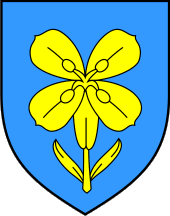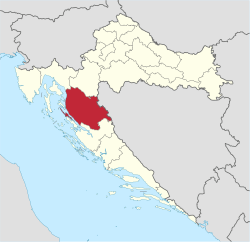Lika-Senj County
Lika-Senj County (Croatian: [lǐːka sɛ̂ːɲ], Croatian: Ličko-senjska županija) is a county in Croatia that includes most of the Lika region and some northern coastline of the Adriatic near the town of Senj, including the northern part of the Pag island. Its center is Gospić.
Lika-Senj County Ličko-senjska županija | |
|---|---|
 Flag  Coat of arms | |
 Lika-Senj County within Croatia | |
| Country | Croatia |
| County seat | Gospić |
| Government | |
| • Župan | Darko Milinović |
| Area | |
| • Total | 5,353 km2 (2,067 sq mi) |
| Population (2011)[2] | |
| • Total | 50,927 |
| • Density | 9.5/km2 (25/sq mi) |
| Area code | 053 |
| ISO 3166 code | HR-09 |
| HDI (2017) | 0.798[3] high · 14th |
| Website | www |
The county is the least populated (45.184 in 2018) and among the least prosperous ones, though it is the largest county in the country by area and includes the Plitvice Lakes National Park and Sjeverni (North) Velebit National Park, some of Croatia's major tourist attractions.
Geography
The county has a total area of 5353 km2.
Administrative division
Lika-Senj County is administratively subdivided into 12 units of local government:
Demographics

| Historical populations of Lika-Senj County | |||||||||||||||||||||||||||||||||||||||||||||||||||||||
|---|---|---|---|---|---|---|---|---|---|---|---|---|---|---|---|---|---|---|---|---|---|---|---|---|---|---|---|---|---|---|---|---|---|---|---|---|---|---|---|---|---|---|---|---|---|---|---|---|---|---|---|---|---|---|---|
|
| ||||||||||||||||||||||||||||||||||||||||||||||||||||||
| Source: Naselja i stanovništvo Republike Hrvatske 1857–2001, Croatian Bureau of Statistics, Zagreb, 2005 | |||||||||||||||||||||||||||||||||||||||||||||||||||||||
Since the early 20th century the county's population has been shrinking. As of the 2011 census, the county had 50,927 residents. The population density is 9.5/km2.
Croatian State Bureau of Statistics estimated population of the county to stand at 45,493 in 2017,[4] and 45,184 in 2018.[5]
Ethnic composition
Ethnic Croats form the majority with 84.15% of the population, followed by Serbs at 13.65%.[6] Serbs form majority in municipalities of Vrhovine, Donji Lapac, and Udbina.
In 1991, before the outbreak of the Croatian War of Independence and the Breakup of Yugoslavia, Croats comprised 59.7% of the population, while Serbs comprised 37%. The area of the county used to have a significant Serb population, mostly located in the eastern part of the county, where they formed a majority. The entire former Lika-Krbava County, loosely overlapping with the area of the modern Lika-Senj county, in censuses of 1900 and 1910 even registered Serb majority (51.2% and 50.8%, respectively).
References
- Ostroški, Ljiljana, ed. (December 2015). Statistički ljetopis Republike Hrvatske 2015 [Statistical Yearbook of the Republic of Croatia 2015] (PDF). Statistical Yearbook of the Republic of Croatia (in Croatian and English). 47. Zagreb: Croatian Bureau of Statistics. p. 62. ISSN 1333-3305. Retrieved 27 December 2015.
- "Population by Age and Sex, by Settlements, 2011 Census: County of Lika-Senj". Census of Population, Households and Dwellings 2011. Zagreb: Croatian Bureau of Statistics. December 2012.
- "Sub-national HDI - Area Database - Global Data Lab". hdi.globaldatalab.org. Retrieved 2018-09-13.
- "PROCJENE STANOVNIŠTVA REPUBLIKE HRVATSKE U 2017./POPULATION ESTIMATE OF REPUBLIC OF CROATIA, 2017". www.dzs.hr. Retrieved 2019-06-13.
- "PROCJENE STANOVNIŠTVA REPUBLIKE HRVATSKE U 2018./POPULATION ESTIMATE OF REPUBLIC OF CROATIA, 2018". www.dzs.hr. Retrieved 2019-10-14.
- "Population by Ethnicity, by Towns/Municipalities, 2011 Census: County of Lika-Senj". Census of Population, Households and Dwellings 2011. Zagreb: Croatian Bureau of Statistics. December 2012.
External links
| Wikimedia Commons has media related to Lika-Senj County. |
- Official website
